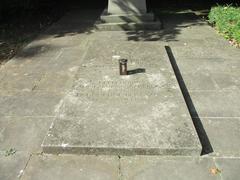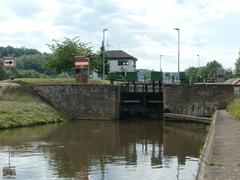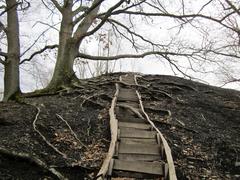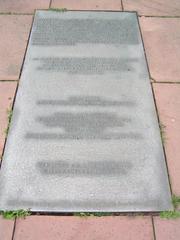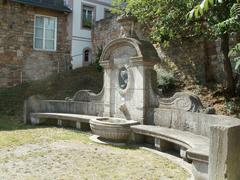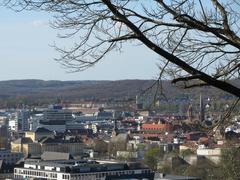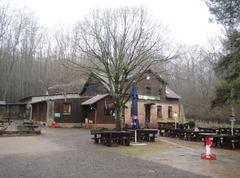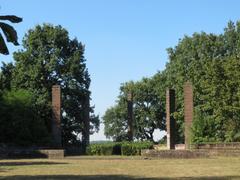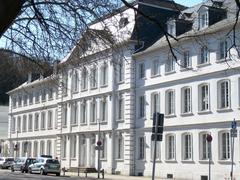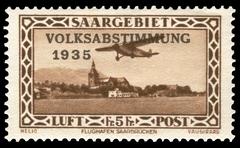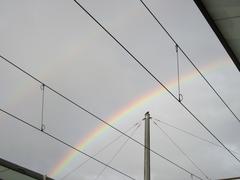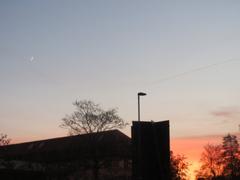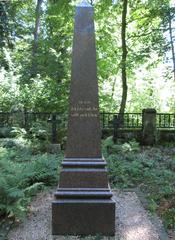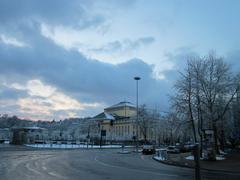
Visiting the Staatskanzlei Saarbrücken, Germany: Guide, Tickets, Hours, and Tips
Date: 04/07/2025
Introduction: The Staatskanzlei Saarbrücken—History and Cultural Significance
Situated in the heart of Saarbrücken, the Staatskanzlei Saarbrücken stands as a symbol of Saarland’s rich heritage, political evolution, and cross-border identity. Serving as the executive office of the Saarland state government, the Staatskanzlei is both an administrative hub and a cultural landmark. Its architectural presence and historical significance reflect centuries of development— from medieval foundations, through Baroque transformations, to modern political autonomy. Though primarily a working government building, the Staatskanzlei occasionally welcomes the public during special tours and events, offering a rare glimpse into Saarland’s unique political and cultural journey at the crossroads of German and French influence. Its central location on Ludwigsplatz, alongside landmarks like Saarbrücken Castle and Ludwigskirche, makes it a focal point for exploring the region’s Baroque heritage and dynamic civic life (Saarland.de, Germany Travel, Kosmos Project).
Table of Contents
- Introduction: The Staatskanzlei Saarbrücken—History and Cultural Significance
- Historical Background
- Visiting the Staatskanzlei Saarbrücken: Practical Information
- Architectural and Administrative Significance
- The Staatskanzlei Today and Its Role in European Cooperation
- Nearby Attractions and Recommendations
- Frequently Asked Questions (FAQ)
- Conclusion and Final Tips
- References
Historical Background
Early Origins and Medieval Foundations
Saarbrücken’s origins date back over a millennium. The city was first mentioned in 999 CE, when Emperor Otto III granted the Sarabruca castle and lands to the Bishopric of Metz (Saarland.de). Over time, Saarbrücken became an administrative center shaped by a succession of territorial rulers, which is reflected in the coats of arms now found in the Saarland state emblem. The region’s layered feudal history is a testament to its strategic importance and early political complexity (Saarland.de).
Baroque Transformation and Prussian Influence
The Baroque era, particularly the 18th century under the Nassau-Saarbrücken counts, transformed Saarbrücken into a city of grand palaces and squares. Notable works like Saarbrücken Castle and Schlossplatz showcase the city’s Baroque heritage (Germany Travel).
The 19th century brought Prussian rule after the Congress of Vienna, catalyzing industrialization—especially in coal mining and steel production. Prussian administration established mining headquarters and welfare facilities, shaping Saarbrücken’s urban landscape (Google Arts & Culture, Google Arts & Culture).
Twentieth Century: Shifting Borders and Political Identity
The 20th century saw Saarland’s borders and political affiliations shift repeatedly. After World War I, the region was administered by the League of Nations with French control over its coal. In 1935, a plebiscite returned Saarland to Germany. Following World War II, it was economically attached to France and only regained full political integration into the Federal Republic of Germany in 1957 (Saarland.de). The Staatskanzlei evolved as the seat of the Prime Minister, central to Saarland’s political navigation between France, Germany, and Europe (Kosmos Project).
Visiting the Staatskanzlei Saarbrücken: Practical Information
Visiting Hours and Tickets
As an active government office, the Staatskanzlei is not open to daily public visitation. However, guided tours and open house events are occasionally organized, especially during cultural festivals and special occasions. Visit the official Staatskanzlei website for up-to-date details on available tours and event registration.
Accessibility
The building and surrounding Ludwigsplatz are accessible to visitors with disabilities, featuring ramps and accessible pathways. Public transport links make reaching the Staatskanzlei and nearby attractions straightforward.
Guided Tours and Special Events
Guided tours (when available) offer insights into the Staatskanzlei’s role, architecture, and history. Tours are generally offered in German, with occasional French or English options, reflecting Saarland’s multilingual character. The Staatskanzlei also hosts exhibitions and participates in large-scale civic events such as German Unity Day (Saarland.de – Veranstaltungen).
Travel Tips and Photographic Spots
- Best time to visit: Spring and early autumn combine pleasant weather with cultural festivities.
- Photography: The exterior is photogenic, situated near Saarbrücken Castle and the Baroque Ludwigskirche. Interior photography may be restricted during events—always ask before taking photos.
- Combine visits: Plan to explore nearby St. Johanner Markt and the Saarland Museum for a full cultural experience.
- Language: Most tours are in German; check ahead for other language options.
Architectural and Administrative Significance
Located at Ludwigsplatz 14, the Staatskanzlei’s modernist architecture (built in the 1950s) reflects post-war functionality, harmonizing with the surrounding Baroque urban landscape (Wikipedia: Saarländische Staatskanzlei). Its design as an “Atriumbau” (atrium building) ensures light-filled, efficient spaces for government work. The façade and flag displays symbolize Saarland’s layered German and Franco-German identity, with strict protocol for flag arrangements during official events (Saarland Beflaggung).
The Staatskanzlei Today and Its Role in European Cooperation
The Staatskanzlei coordinates Saarland’s government policy, represents the state in the Bundesrat and EU, and manages cross-border relations—particularly with France and Luxembourg. Leadership changes, such as Dr. Deniz Alkan’s appointment as head of the Europe Department in 2024, highlight ongoing commitment to European cooperation (Voisins-Nachbarn). The office’s strategic location continues to position Saarland as a bridge between nations (Kosmos Project).
Nearby Attractions and Recommendations
Enhance your visit by exploring:
- Saarbrücken Castle: Baroque palace with gardens and river views.
- Ludwigskirche: Iconic Rococo Protestant church.
- St. Johanner Markt: Bustling square with cafes and shops.
- Saarland Museum and Mining Heritage Sites: Dive into regional art, industry, and history.
All sites are within walking distance or easily accessed by public transport.
Frequently Asked Questions (FAQ)
Q: What are the Staatskanzlei Saarbrücken visiting hours?
A: No regular public hours; check Saarland.de for special events and tours.
Q: How can I get tickets for a tour?
A: Book tours or special event access via the official website.
Q: Is the building accessible for visitors with disabilities?
A: Yes; features include ramps, elevators, and accessible restrooms.
Q: What other attractions are nearby?
A: Saarbrücken Castle, Ludwigskirche, St. Johanner Markt, and the Saarland Museum.
Q: Can I take photos inside?
A: Exterior photography is allowed; interior photography may be restricted during official events.
Conclusion and Final Tips
The Staatskanzlei Saarbrücken is more than a government building—it is a gateway to Saarland’s layered history and European identity. While everyday access is limited, special events and guided tours offer rare opportunities to explore its history, architecture, and role in fostering Franco-German cooperation. Combine your visit with nearby historical sites for a rich, immersive experience.
To stay informed about upcoming events, tours, and Saarland’s political life, consult the official Staatskanzlei website and consider downloading the Audiala app for guided tours and real-time updates.
References
- Discover the Staatskanzlei Saarbrücken: A Historical and Cultural Landmark, 2025, Saarland.de (Saarland.de)
- Exploring the Staatskanzlei Saarbrücken: Architectural Marvel and Political Hub in Saarland, 2025, Germany Travel (Germany Travel)
- The Heritage Mining in Saarland - Staatskanzlei Saarland, 2025, Google Arts & Culture (Google Arts & Culture)
- The Heritage Mining in Saarland - Staatskanzlei Saarland Part VIII, 2025, Google Arts & Culture (Google Arts & Culture)
- Saarland Politics and Administration, 2025, Saarland.de (Saarland.de)
- Staatskanzlei des Saarlandes, 2025, Kosmos Project (Kosmos Project)
- Neuer Leiter der Europa Abteilung in der Staatskanzlei, 2024, Voisins-Nachbarn (Voisins-Nachbarn)
- Saarland Staatskanzlei Official Website, 2025, Saarland.de (Saarland.de)

